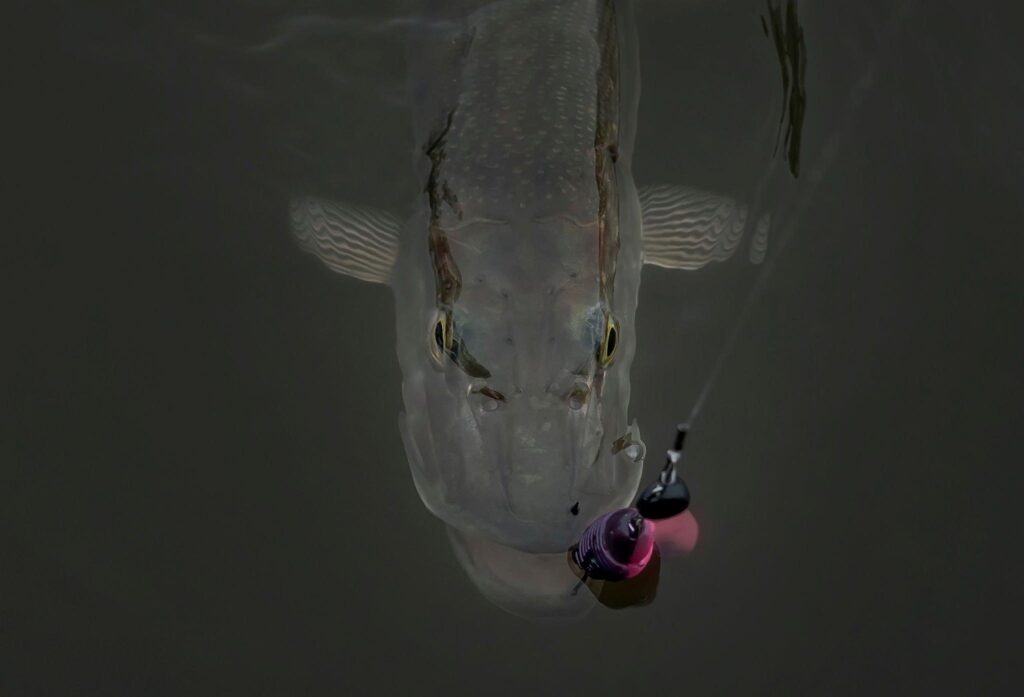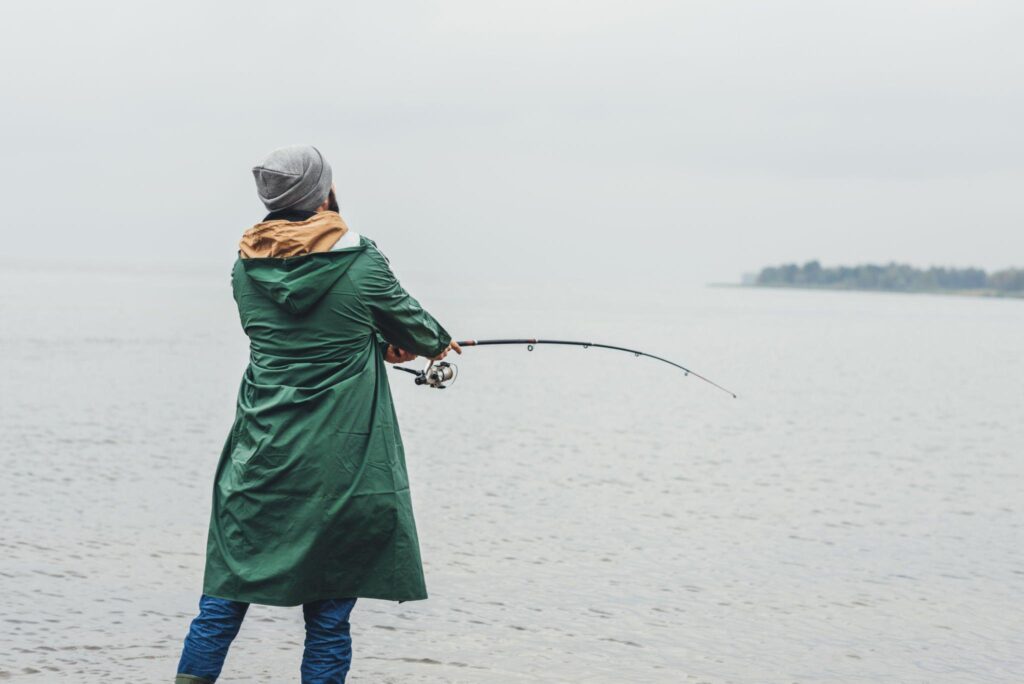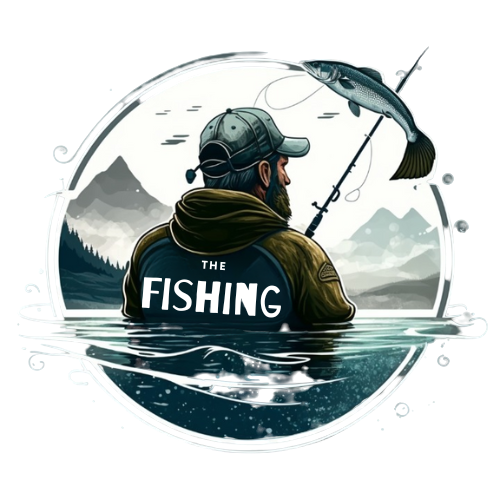When the skies open up and it starts to pour, most anglers head for cover. Many anglers assume that rainy weather hurts fishing success and often raise the question: Do fish bite in the rain?
However, fishing in the rain can actually lead to some of the best catches of the year if you understand how rainfall affects fish behavior.

Table of Contents
- Do Fish Bite More or Less in the Rain?
- Why Fish Become More Active When It Rains
- Timing Your Fishing After Rainfall for Best Results
- What fish bite best in the rain?
- Should you fish differently in light rain versus heavy rain or storms?
- Adjusting Your Fishing Strategy for Rainy Weather
- The Pros and Cons of Fishing in the Rain
- Tips for Making the Most of Rainy Fishing Days
- Should you fish in different spots when it rains?
- What tackle and baits work best for rain fishing?
- The Bottom Line: Do Fish Bite in the Rain?
Do Fish Bite More or Less in the Rain?
Yes, Fish bite more in the rain.
Common wisdom says that fishing is poor when it’s raining. The typical belief is that fish become inactive and stop feeding when the rain starts.
However, scientific research and experienced anglers alike have found that’s simply not true.
In reality, fish often become more active and feed aggressively when it rains. The rain triggers certain conditions and changes that spur fish into a feeding frenzy.
By learning to take advantage of these patterns, you can discover amazing fishing success even on the rainiest days.
Why Fish Become More Active When It Rains
There are several factors at play that cause fish to bite more when it rains.

Here are some of the main reasons rain gets fish biting:
Increased Food Supply After Rainfall
A rainstorm washes bugs, worms, and other potential fish food sources into the water from the shoreline and surface. This increased food supply triggers feeding activity as fish gorge on easy meals. The more rain, the more food gets swept into the water.
Fish Take Advantage of Murky Water
Rain churns up sediment and makes the water murky and cloudy. All that suspended particulate matter means less visibility underwater. Fish use this to their advantage, feeling more comfortable moving and ambushing prey in low visibility conditions.
Cooler Water Temperatures After Rain
Rainfall drops the temperature at the surface of the water. As deeper, cooler water mixes with the warmer surface layer, it lowers the overall water temperature. Cooler water holds more oxygen, stimulating fish to feed more aggressively.
How Barometric Pressure Changes Affect Fish
Dropping barometric pressure signals a coming rainstorm. Fish sense the pressure change through their air bladders. This triggers an instinct to feed heavily before seeking shelter when the storm arrives.
Timing Your Fishing After Rainfall for Best Results

To maximize your catches, it’s important to pay attention when you head out after rain. The timing depends on several factors:
How Long to Wait Before Fishing After Rain
If it’s just a brief shower, fishing can be good during and immediately after the rain. For heavy downpours or thunderstorms, it’s best to wait at least 2 to 6 hours for conditions to stabilize before fishing.
Which Fish Tend to Be Most Active
Some species like bass, walleye, and catfish get very active with rainfall. Trout may take a little longer to get fed after a storm. Just after rain is prime time for fast fishing action.
Related: Trout Fishing In The Rain: A Guide To Success
What fish bite best in the rain?
Some species are particularly stimulated to bite when it rains:

| Fish Species | Why They Bite in the Rain |
|---|---|
| Bass | Largemouth and smallmouth bass gorge on baitfish washed into ponds and become more active hunting in murky water. |
| Walleye | Cooler temperatures and increased water flows after rain really turn on walleye feeding. Jigs and crankbaits can produce. |
| Catfish | Channels cats feed heavily before storms. Rain boosts scent dispersion for bait. Bullheads bite well in muddy conditions. |
| Crappie | Rain and rising water levels boost stream trout activity. Use spinners, spoons, and drift baits in heavier flows. |
| Trout | Rain and rising water levels boost stream trout activity. Use spinners, spoons and drift baits in heavier flows. |
| Striped Bass | Striper fishing can excel in rain and wind. They chase baitfish forced to surface in choppy water. |
Should you fish differently in light rain versus heavy rain or storms?

Light rain usually means excellent fishing with active fish and minimal negative effects. During steady downpours or thunderstorms, it’s safest to seek shelter until the heaviest weather passes.
After intense rain wait a couple hours for conditions to settle before fishing. Heavy flows and muddy water take time to stabilize.
Adjusting Your Fishing Strategy for Rainy Weather
Fishing techniques and gear that work great on sunny days may not be as effective when it’s raining. Here are some useful strategies to employ:
Best Baits and Lures for Rainy Conditions
Live worms and minnows are very productive when it’s raining since the real movement triggers strikes. Bright-colored lures and spinnerbaits work well in muddy water.
Fishing Techniques That Work Best in the Rain
Slow-moving baits excel when visibility is poor. Jigs, Texas rig plastics, and suspending jerk baits are good choices. Be prepared to hook hard-fighting fish.
Choosing Productive Fishing Locations
Focus on moving water areas like creek inflows and current breaks where fish congregate to find food washing in. Target sheltered spots like docks and overhangs.
The Pros and Cons of Fishing in the Rain

While rainy weather fishing has advantages, there are also some potential downsides to consider:
| Pros | Cons |
|---|---|
| Increased feeding activity by fish | Potentially dangerous lightning |
| Lower fishing pressure from other anglers | Slippery and unsafe surfaces |
| Higher catch rates | Discomfort from being wet and cold |
| More aggressive fish to catch | Difficulty handling gear and equipment |
| New food sources washing into the water | Reduced visibility for finding spots and landing fish |
| Easy to fish secretly | Harder to detect subtle bites |
| Cooler water temperatures | Having to wear bulky rain gear |
| Prime conditions for many species | Challenging to stay dry |
| Murky water makes fish less wary | Possible flash flooding risks |
| Ability to catch bigger fish | Harder to control and cast baits |
| Fresh oxygen pumped into the water | Messy cleanup after fishing |
Tips for Making the Most of Rainy Fishing Days
Don’t let a little rain spoil your fishing plans. With the right preparation, you can enjoy amazing catches on rainy days:
- Dress for the conditions with proper rain gear and waterproof boots.
- Bring plenty of towels and drying cloths to keep gear and hands dry.
- Use bobbers and floating baits to detect more bites in choppy water.
- Target protected structure and focus on slower-moving baits.
- Stay alert for when the rain triggers a feeding frenzy!
Should you fish in different spots when it rains?

It’s a good idea to target different types of spots when fishing in the rain compared to normal sunny conditions. Focus on areas where baitfish and food sources will collect, like creek inflows, shallow beaches, and current breaks.
Also concentrate efforts around overhead cover like docks, overhanging trees, and bridges where fish will shelter. Moving baits slowly along the bottom structure also works well in murky rainy water.
What tackle and baits work best for rain fishing?
When fishing in the rain, use gear suited to murky, choppy conditions. Spinning tackle with simple bobber/sinker rigs and floating baits makes it easier to see bites.
Scented, noisy lures like spinnerbaits and crankbaits help grab attention. Soft plastic baits are presented slowly on jig heads produced in dirty water. Use darker bait colors like black, blue, and purple for cloudy conditions.
The Bottom Line: Do Fish Bite in the Rain?
Of Course, fish bite in the rain due to high activity. For experienced anglers, fishing in the rain can certainly be rewarding thanks to the increased fish activity it brings. Novice anglers may want to wait for drier conditions to have an easier time learning. With the right rain gear and preparation, wet-weather fishing can give your catch rates a healthy boost!
